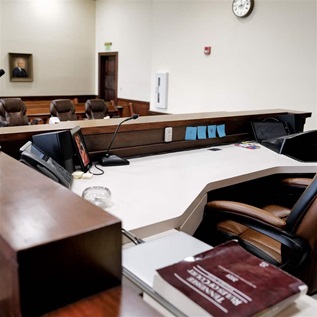New Report Assesses Meth's Impact on Children, Families and Nation's Foster Care System
A new report chronicling the harmful effect of methamphetamine (meth) on children, families and our nation's foster care system was released today at an event on Capitol Hill. The report and the event, convened by Generations United and a group of cosponsors, featured the stories of grandparent caregivers, case workers, doctors and others “on the frontlines of foster care” who have felt the tragic impact of meth, and witnessed the lasting toll it exacts from families and communities across the U.S.
“This report describes the important role grandparents and other relatives play when they step up to care for children in crisis. Because of meth and other problems, these grandfamilies are working side-by-side with child welfare professionals to minimize the impact on children – they have become lifelines for so many hurt children,” stated Donna Butts, Executive Director of Generations United. “These caregivers need adequate support in order to help the children they care for exit foster care to join safe, permanent, loving families.”
Titled Meth and Child Welfare: Promising Solutions for Children, Their Parents and Grandparents, the report illustrates the destructive impact meth is having on children, the child welfare systems that protect them, and America's families.
“To truly address the impact of meth abuse on children and families, national changes are urgently needed to bring about more flexibility in child welfare policy and practice, while ensuring a reliable, sufficient source of funding,” stated Joe Kroll, Executive Director of the North American Council on Adoptable Children, a cosponsor of the event to release the report, “This report illustrates that the challenges of meth amplify the problems that have long plagued our child welfare system – particularly an inflexible federal financing structure that encourages placement of children in foster care, rather than supporting services that keep children from entering foster care or limit the time they spend in care.”
Promising solutions exist. One such solution emphasized in GU's report is subsidized guardianship. Subsidized guardianship programs provide financial support to allow children to leave the foster care system to live with a permanent family – often a grandparent or another relative – that has agreed to provide a safe, loving home. This option is particularly important for older youth who may not want to be adopted or grandfamilies who do not want to disrupt existing family relationship by terminating parental rights. Currently, an estimated 20,000 children living with relatives in foster care could exit care if a permanency option like federally supported guardianship was available.
The national, nonpartisan Pew Commission on Children in Foster Care included subsidized guardianship among the recommendations it offered to reform our nation's foster care system. The blue-ribbon Commission conducted a comprehensive assessment of U.S. foster care, and crafted recommendations – focused on federal financing and court oversight of foster care – designed to improve outcomes for foster children. The Commission determined that subsidized guardianships would allow more children to leave foster care for a safe, permanent family. “In most cases of violence or abuse, a child may be removed from one parent, said Dennis Sutton, CEO of the Children's Home Society in West Virginia. “With meth, children often go into foster care because they lose both of their parents to the drug.”
A few examples of meth's impact on children, families and the child welfare system:
- Some geographic areas, particularly rural areas with a shortage of service and treatment options, are seeing significant increases in placements due to meth. The report includes examples where statewide meth-related increases in child welfare placements have been documented, including California, Colorado, Iowa, Minnesota, Montana, and North Dakota.
- In a recent survey of 13 states, 40% of child welfare officials reported an increase in out-of-home placements in the last year due to meth.
- Meth affects many systems simultaneously. By 2004, 40% of law enforcement agencies reported meth as their number one drug problem.
- Unlike other drugs, women are more likely to use meth. They are also more likely to be single parents who live alone with their children. Additionally, meth abuse has increased substantially among pregnant women – between 1995 and 2003, there has been an 86% increase in the number of pregnant women seeking treatment for meth addiction.
- Between 2000 and October 15, 2005, meth lab seizures by local or federal law enforcement affected approximately 15,192 children, including at least 3,800 children exposed to toxic chemicals, 96 lab-related injuries, and 8 deaths.
“We've done a good job at taking Sudafed off the shelves, but we need to do better at dealing with the sheer numbers of people who need treatment,” said Annie Zander, an Oregon mother who successfully battled her addiction to meth to be reunified with her young son. She now works with a parenting program, and mentors other women trying to beat addiction and keep their families together.
“We need to believe that change is possible,” explains an adoptive father of eight-year-old twins, whose birth mother recently entered treatment for meth dependence after twelve years of substance abuse. “If we lose hope, we might as well pack it in.”
Briefing co-sponsors: Generations United, House Caucus to Fight and Control Methamphetamine, National Indian Child Welfare Association Inc., Child Welfare League of America, Children's Law Center/Home at Last, North American Council on Adoptable Children.
About Generations United
Generations United (www.gu.org) is the only national membership organization focused solely on improving the lives of children, youth, and older people through intergenerational strategies, programs, and public policies. GU represents more than 100 national, state, and local organizations and individuals representing more than 70 million Americans. Since 1986, GU has served as a resource for educating policymakers and the public about the economic, social, and personal imperatives of intergenerational cooperation. GU acts as a catalyst for stimulating collaboration between aging, children, and youth organizations providing a forum to explore areas of common ground while celebrating the richness of each generation.











